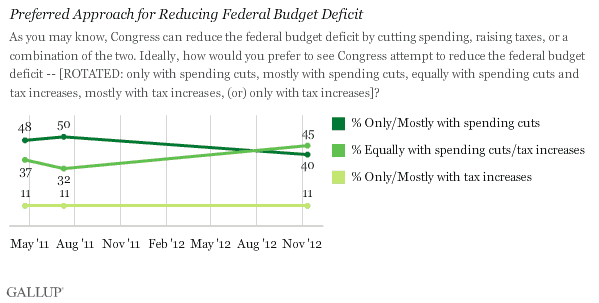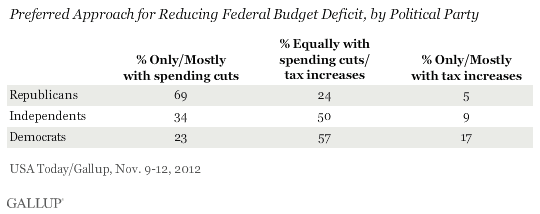PRINCETON, NJ -- Forty-five percent of Americans now say they favor reducing the federal budget deficit with an equal balance of tax increases and spending cuts, up from 32% last year. At the same time, the percentage favoring an emphasis on spending cuts is now 40%, down from 50% last year, while the percentage in favor of reducing the deficit primarily through tax increases is unchanged at 11%.

With 45% of Americans favoring an equal amount of spending cuts and tax increases, and another 11% favoring a greater emphasis on tax increases, the Nov. 9-12 USA Today/Gallup poll suggests that a majority of Americans, 56%, are now open to the idea of reducing the deficit equally or mostly with tax increases. In July 2011, 43% favored deficit reduction either equally or mostly through tax increases, and in May 48% did.
Overall, as was the case last year, most Americans -- now 85% -- are comfortable with achieving deficit reduction mostly (40%) or equally (45%) with spending cuts.
The 2011 polls were conducted in advance of government negotiations to raise the federal debt limit. Those negotiations resulted in the appointment of a bipartisan debt reduction "supercommittee" tasked with finding ways to get budget deficits under control. The failure of the supercommittee to reach agreement led to a schedule of automatic tax increases and spending cuts, due to take effect on Jan. 1. President Obama and Congress are now turning their attention to finding ways to avoid the so-called fiscal cliff.
It is unclear to what extent Americans' greater willingness to consider tax increases is related to this unwelcome fiscal deadline. The Nov. 9-12 poll did find the vast majority of Americans saying it was important for government leaders to take action to avoid the fiscal cliff measures.
Most Republicans Still Prefer Focus on Spending Cuts
Republicans are distinct from independents and Democrats in their decided preference for achieving deficit reduction mostly through spending cuts. Sixty-nine percent of Republicans say the government should cut the deficit only or mostly through spending cuts. Meanwhile, half of independents and 57% of Democrats prefer a balanced approach calling for equal amounts of tax increases and spending cuts. Democrats are the most willing of the party groups to favor a deficit-reduction strategy focused mainly on tax increases.

Republicans' views are essentially the same as they were in July 2011, but both independents (up 20 percentage points) and Democrats (up 15 points) now favor a plan to reduce the deficit through equal shares tax increases and spending cuts.
Implications
The fiscal cliff measures were designed as a draconian outcome that neither party would find acceptable, in hopes that the deficit supercommittee would be able to make difficult choices to develop a plan for meaningful deficit reduction. The supercommittee was unable to do so; therefore, as the situation stands today, the fiscal cliff measures will become reality. Now the president and Congress will make another attempt in the coming weeks to find an alternative to the fiscal cliff.
At this point, Americans appear more willing than last year to consider tax increases as a substantial part of a deficit reduction approach. However, that increase is seen mainly among Democrats and independents. Thus, Republican leaders must decide whether to follow the wishes of the party's rank-and-file supporters and put a lesser emphasis on tax increases, or to compromise and move in a direction of a balanced approach now favored by the greatest number of Americans overall.
Survey Methods
Results for this USA Today/Gallup poll are based on telephone interviews conducted Nov. 9-12, 2012, with a random sample of 1,009 adults, aged 18 and older, living in all 50 U.S. states and the District of Columbia.
For results based on the total sample of national adults, one can say with 95% confidence that the maximum margin of sampling error is ±4 percentage points.
Interviews are conducted with respondents on landline telephones and cellular phones, with interviews conducted in Spanish for respondents who are primarily Spanish-speaking. Each sample includes a minimum quota of 400 cellphone respondents and 600 landline respondents per 1,000 national adults, with additional minimum quotas among landline respondents by region. Landline telephone numbers are chosen at random among listed telephone numbers. Cellphone numbers are selected using random-digit-dial methods. Landline respondents are chosen at random within each household on the basis of which member had the most recent birthday.
Samples are weighted by gender, age, race, Hispanic ethnicity, education, region, adults in the household, population density, and phone status (cellphone only/landline only/both, cellphone mostly, and having an unlisted landline number). Demographic weighting targets are based on the March 2011 Current Population Survey figures for the aged 18 and older population living in U.S. All reported margins of sampling error include the computed design effects for weighting.
In addition to sampling error, question wording and practical difficulties in conducting surveys can introduce error or bias into the findings of public opinion polls.
View methodology, full question results, and trend data.
For more details on Gallup's polling methodology, visit www.gallup.com.
